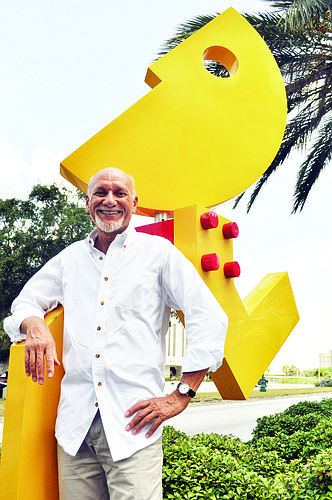- November 28, 2024
-
-
Loading

Loading

In his untucked, white button-down, khakis and stark-white goatee, Jorge Blanco looks like he walked off the set of a Sean Connery movie. The blackest of black sunglasses shield his eyes as he leans against his car with his arms folded across his chest, looking like the ultimate villian.
Blanco heads into Art Center Sarasota clutching a manila envelope — inside, there’s a sheet of paper with the image of a small island, palm tree, sun and a funny-looking little man who resembles the shape of a cactus.
“Everybody maybe has this feeling,” Blanco says, “When you are in traffic or working, have a problem with family, or worried about society, politics or the planet. You would like to go to a little place alone with no possessions and say goodbye to everybody — the beautiful place beside the sea. This is the philosophy of my character.”
In the 1970s, Blanco was studying art in Italy. He found cartoons to be an important mass communication and made his living by making political cartoons for various publications. When he returned to Venezuela in 1979, he received an offer to illustrate a newspaper for children in Caracas, but had already developed an idea for his own comic strip and pursued that instead. In 1980, he created “The Castaway,” which became an overnight success. He submitted it to several newspapers and magazines, where it was printed for 20 years. It appeared on television and was also published in eight books.
“The Castaway’ is a little man who is very skinny because he doesn’t have a lot of food, and naked because clothes aren’t necessary,” Blanco says. “There’s no Target, no T.J. Maxx, no dress store. And he is happy on this beautiful island, but the island is a fantasy. He has companions; the pelican, the fishes.”
How the character arrived to the island is a mystery — not even Blanco knows. There was no shipwreck, no crashed plane. In the first cartoon, the character appears alone, dreaming on the island. Blanco explains that because there are no words, everyone can understand the story. The idea is to transmit simplicity and minimalism to the reader. It reflects the desire for escape and evading reality.
Blanco moved in 1999 to the United States, and in 2005, became an American citizen. He dedicated himself to sculpture and for the past 26 years, developed public art that graces the area with color and geometric form. But now, after 11 years, Blanco is bringing back the skinny little man and his dreams.
“I love ‘The Castaway,’ and sometimes I miss him,” he says. “He is my friend, and I would like to see him again. In my home, he is not alive; he is sleeping. He needs the people, a lot of people, because he is a dream.”
Blanco need not miss his skinny little “friend” any longer. Beginning with this week’s editions, “The Castaway” will be printed each week in The Longboat Observer, The East County Observer and The Sarasota Observer.
LOCAL INSPIRATIONS
Jorge Blanco’s sculptures can be seen around Sarasota, Longboat Key and Venice.
1. “SMILE” / 2000 / 12 feet tall / Indigo Hotel / Tamiami Trail / Sarasota.
2. “THE RUNNERS” / 2001 / 8 feet tall / Tamiami Trial and Boulevard of The Arts / Sarasota.
3. “CARTWHEEL” / 2002 / 6 feet tall / Gulf Gate elementary School / Sarasota.
4. “PHOENIX” / 2002 / 15 feet tall / Anderson Administration Center, Venice.
5. “TO BE RED” / 2004 / 7 feet tall / Center for the Arts / Longboat Key.
Public art
It was French abstract painter Auguste Herbin’s geometric shapes and colors that first inspired Jorge Blanco to pursue art.
His studies took him to the Academy of Fine Arts in Rome, Italy, where his work in sculpture was characterized by dark and intense realism that portrayed repression, torture and oppression. He showed his first sculpture in 1974 in Caracas.
In the early 1990s, his attitude changed. His sculptures began to represent light, humor and color. They portrayed the world’s beauty, the love he felt for his family and happiness.
Since 1999, Blanco has lived and worked on the west coast of Florida. He was highlighted by Florida International magazine as a creative individual who helps make Florida a destination, with 13 sculptures installed in nine cities across the United States and most recently, in Uruguay.
One of the main forces behind his work is creating public art. In 2005, Florida International magazine named Blanco as one of Florida’s Top 100 Power Players. Blanco says he is convinced that it serves a double purpose — introducing everyone to art, while also contributing to the advancement of communities.